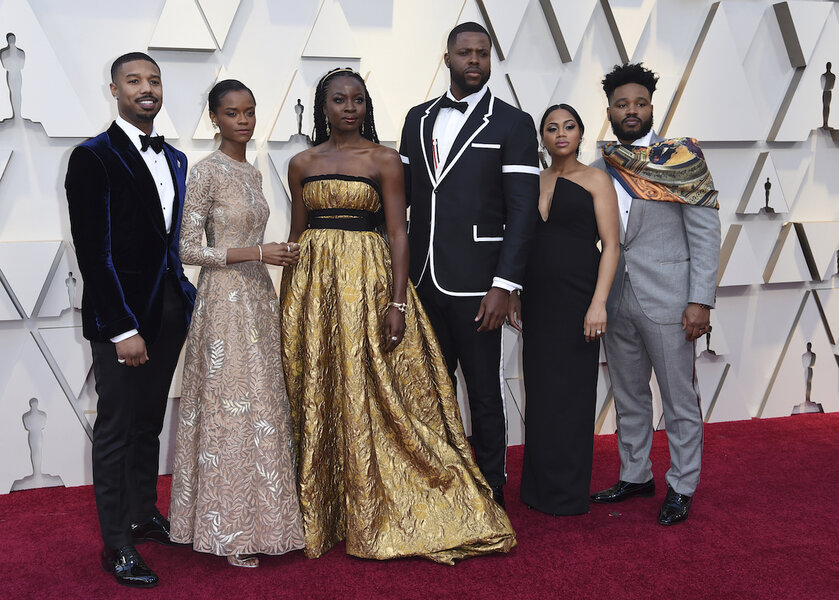Hollywood finally gets the message – diversity is good for business
Loading...
In 2015, dismayed by the lack of people of color nominated for Oscars, former lawyer April Reign composed a tweet with the hashtag #OscarsSoWhite.
“There’s no shortage of Latina actresses. There’s no shortage of black actors,” Ms. Reign told the Monitor in 2016. “It’s just making sure that everyone has an opportunity [to compete] and then just picking the best-qualified person once you’ve leveled the playing field.”
A few years and 147,000 Twitter followers later, Ms. Reign’s call to action has compelled the Academy of Motion Picture Arts and Sciences to pledge to double the number of women and people of color in its ranks by 2020. Ms. Reign was invited to this year’s Oscars, which honored the most women and minority nominees to date.
Why We Wrote This
At its best, the film industry offers moviegoers a reflection of themselves. Historically, however, those reflections have been strikingly monochromatic. But that appears to be changing.
The #OscarsSoWhite wake-up call is heralded as one catalyst of increasing equality in Hollywood. While there’s still room for improvement, women and people of color led movies in record numbers in 2018.
U.S. films featuring a woman in a leading role climbed 20 percent in the past decade, according to a new study from the University of Southern California’s Annenberg Inclusion Initiative. The report found that 40 of the top 100 highest-grossing films in the past year were led by women, and 28 were led by minorities. The presence of at least one woman of color in a leading role at every major studio contributed to progress seen in 2018, suggest the study’s authors.
Representation of races and ethnicities, however, still doesn’t reflect the diversity of the general public. Minorities make up 40 percent of the U.S. population; by 2045, that population is projected to reach majority.
While people of color have made gains in the film industry over the past few years, they are still underrepresented across all Hollywood jobs. Native women and women from the Middle East are especially absent from film roles that drive the storyline.
Television, however, has made particularly promising strides for minorities, according to the annual Hollywood Diversity Report out of University of California, Los Angeles (UCLA).
At first glance, it’s troubling: People of color in broadcast scripted shows account for only around two out of 10 lead roles. But that’s a major improvement from when UCLA began its reporting in 2011: The number of people of color in starring TV roles has more than quadrupled.
Darnell Hunt, a UCLA professor of sociology and African-American studies who co-wrote the report, has watched how industry attitudes toward fairer representation have evolved over the years. If diversity on screen seemed like a luxury a decade ago, audiences expect it today. “Over time, as it became clear that audiences were becoming more diverse and that they were demanding diverse content, diversity itself was seen as a business imperative,” Mr. Hunt told NPR.
Diversity is indeed good for business. Top-grossing films with female leads outperformed those with male leads at the box office each year between 2014 and 2017 regardless of budget.
Industry observers also credit a certain hiring practice as a catalyst for more equality: the “inclusion rider.”
Embraced by a growing list of stars that includes Michael B. Jordan and Brie Larson, an inclusion rider clause can be inserted into the contracts of sought-after performers to ensure the hiring of more women, people of color, LGBT individuals, people with disabilities, and members of other marginalized communities.
By demanding the inclusive policy, high-profile actors can leverage their status to help others break barriers of entry. While not a quota, the standard inclusion rider calls for “consideration of the deep bench of talented professionals from historically underrepresented groups and strongly encourages hiring and casting of qualified individuals from underrepresented backgrounds.”
Kalpana Kotagal, a partner at the law firm Cohen Milstein Sellers & Toll and a co-writer of the inclusion rider, says that activists and advocates have played a key role in documenting the state of entertainment equality.
“We need to have transparency about what’s actually happened so that it can be measured,” says Ms. Kotagal. “And that measurement allows us to show how stagnant the industry has been.”
But measuring diversity in leading roles as a benchmark for progress can promise only so much. Efforts to level the playing field are vital behind the camera too.
Beyond casting, Ms. Kotagal says it’s also worth examining who gets nominated for awards and whose projects get greenlighted.
Consider women directors: Though their number at the head of top-grossing films doubled from 2016 to 2017, they amounted to only 12.6 percent of the director pool.
Enter the “4% Challenge.” Launched in January by Time’s Up (a nonprofit created in 2017 in response to Hollywood’s #MeToo reckoning), the campaign addresses the fact that only 4 percent of directors who helmed the past decade’s most lucrative films were women. The challenge calls on moviemakers to commit to a feature film with a woman director within 18 months. Several artists and studios have already signed on, including Amazon Studios, MGM Studios, and Warner Bros. Entertainment.
Historic wins at the 2019 Oscars mean more inclusive stories could enter development. Ms. Kotagal was thrilled by “Spider-Man: Into the Spider-Verse” winning an Oscar for best animated feature. The movie’s protagonist is the first Afro-Latino Spider-Man.
“That kind of stereotype-breaking is also part of the story here,” Ms. Kotagal says.






